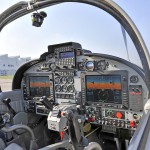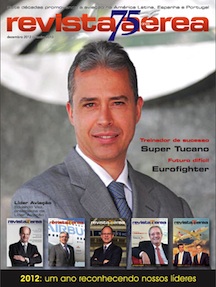Sostenido crecimiento del tráfico de pasajeros en Chile
January 29, 2013
por Sergio Barriga Kreft
Según lo informara la Junta de Aeronáutica Civil de Chile, el tráfico aéreo de pasajeros registró en el 2012 un alza de un 17,3 % con respecto al año anterior, alcanzando a los 15,2 millones, siendo aquel crecimiento, en los vuelos nacionales, de un 18.6 % más que en el 2011, resultando Calama y Copiapó las ciudades que una mayor alza tuvieran.-
En el ámbito internacional, Buenos Aires y Sao Paulo continúan como las que concentran el mayor tráfico de pasajeros y Bogotá, Río de Janeiro y Sydney las rutas de un mayor crecimiento.-
En el aspecto nacional, el importante auge que sigue teniendo, la gran minería del cobre, metal del cual Chile es uno de los mayores productores a nivel mundial, ha significado que el transporte aéreo cumpla un importante rol en el traslado de personas y carga hacia las zonas mineras y nuevos actores estén ingresando al campo de la aviación comercial.-
Por otra parte, en lo que a aeropuertos se refiere, se han anunciado importantes inversiones en la ampliación de los terminales y en la posible construcción de nuevos aeródromos, todo ello con miras a satisfacer una demanda siempre creciente.-
SCAC appoints new President
January 29, 2013
Moscow – January 28 2013
On January 28, 2013 “Sukhoi Civil Aircraft” Company (SCAC) Board of Directors appointed the new President.
Mr Andrey Kalinovsky was named President of “Sukhoi Civil Aircraft” replacing Mr Vladimir Prisyazhnyuk.
Mr. Kalinovsky will take up his duties on February 1, 2013.
During the same Board of Directors’ meeting Mr Mikhail Pogosyan – President and Chairman of the Executive Board of United Aircraft Corporation (UAC) – was appointed SCAC Chairman of the Board replacing Mr. Igor Ozar. The new Chairman commences his duties immediately upon his election.
These new appointments to senior positions are associated with challenging goals set by the Company to boost the Sukhoi Superjet program and ensure the SSJ100 aircraft’s success.
Mr Kalinovsky was formally the General Director of Novosibirsk Aircraft Production Association (named after Chkalov NAPO, Subsidiary of Sukhoi) since July 2007. During this period he implemented the modernization and upgrade of the production facilities together with personnel advanced training at NAPO in order to comply with the international production standards.
He had assumed the role of First Vice President of Production with SCAC and Director of SCAC Komsomolsk-on-Amur Branch since May 2011.
Under Mr Kalinovsky’s direct management, the manufacturing of the SSJ100 components had been arranged in Novosibirsk (Russia) as well as the aircraft assembly line at SCAC Komsomolsk-on-Amur Branch.
Alenia Aermacchi: new version of SF-260 with glass cockpit completes first flight
January 29, 2013
Alenia Aermacchi’s SF-260TP primary and basic trainer, equipped with new digital avionics (Glass Cockpit), an enhanced multi-spectral vision system and an upgraded air conditioning system has completed its first flight in Venegono, Italy. The aircraft is in final testing stages, and potential customers have requested demonstrations of it.
�
The aircraft is equipped with new digital avionics that will increase the SF-260’s competitiveness and will allow the aircraft to play a greater role in the global trainer market.
�
The new cockpit’s layout, based on an integrated digital avionic system, features two large LCD displays (6�8 inches) and one Control Display Unit (CDU) that manage several of the aircraft’s functions. Two Integrated Flight Displays (IFD) incorporate radio, VHF Omnidirectional Range radio-guide (VOR), GPS, and Inertial Platform and Air Data and ensure complete redundancy and top safety for pilots.
The new digital avionics allow for many functions including:
- Presentation of primary flight data (Primary Flight Display) to pilots.
- Radio-guided navigation and GPS autonomous navigation
- Digital Moving Map
- Flight Management System
- Aircraft checklist display
- Multi-spectral vision systems obtained through the integration of an infra-red television camera
- Downloading of flight data for post-flight debriefs
�
The aircraft Enhanced Vision System includes an infra-red television camera installed on the wing leading edge, allowing pilots better visibility at night and in adverse weather conditions.
�
In addition to the new cockpit digital avionics and the EVS, a modern air conditioning system is integrated on the aircraft that guarantees greater comfort for the crew. The new system, characterized by a high cooling capability, is completely electrical and is operated by a Digital Control Display on the instrument panel.
�
The SF-260 is the best seller in the primary training market, with over 900 units delivered worldwide. The market interest for the aircraft is still high, as an undisclosed air force who is already SF-260 customers, having recently ordered 12 additional aircraft.
�
The SF-206 turboprop version, in its new configuration, represents a particularly cost-effective versatile solution, also in severe weather conditions, for filling a variety of military primary and basic training roles.
 |
CHEGOU A QUINTA GERAÇÃO DO CIRRUS SR22
January 24, 2013
A Cirrus acaba de anunciar a quinta geração de suas aeronaves SR22, que já está sendo chamada de “O melhor Cirrus de todos os tempos”.
O novo modelo tem um peso máximo de decolagem aumentado em 200 lbs (90,7 kgs), disponibilizando uma carga útil de 680 kgs. O Cirrus SR22 2013 passa a ser em sua categoria, a aeronave com a maior disponibilidade de carga útil no mercado.
Agora o Cirrus SR22 pode levar cinco pessoas a bordo e todo o combustível suficiente para 7 hs de voo ou 2.000 km de alcance, sem comprometimento de segurança ou performance.
A Cirrus reavaliou inteiramente o projeto da aeronave, reforçando a estrutura da asa e do trem de pouso, redesenhando e substituindo partes, peças e modernizando o CAPS – Sistema de Paraquedas Cirrus. O novo paraquedas comporta um velame de maior tamanho e recebeu um foguete-extrator de geração mais avançada com acionamento elétrico.
As carenagens das rodas do trem de pouso principal foram redesenhadas, o sistema de flaps foi modernizado.
O SR22 virá equipado com Transponder ADS-B qualificando a aeronave a operar de acordo com as mais recentes normas da ICAO (Organização Internacional de Aviação Civil). Poderá vir equipado com o Global Connect, que consiste num telefone por satélite para chamar ou receber ligações no solo ou em voo em qualquer ponto do planeta. Esse sistema habilita a aeronave a receber informações metereológicas em voo e em tempo real.
Inovação é a marca registrada que faz do Cirrus uma aeronave mais segura, mais fácil de voar, de melhor performance e mais versátil ano após ano.
Todo Cirrus novo vem acompanhado de um curso de transição para o piloto, que o qualifica a operar a aeronave conforme os padrões de segurança do fabricante.
Todd Simmons, Vice-Presidente de Vendas e Marketing da Cirrus Aircraft declarou “Um novo patamar foi estabelecido pela equipe de engenharia de nossa empresa que trabalhou incessantemente por 18 meses para desenvolver e certificar essa aeronave com maior peso máximo de decolagem e disponibilizar tanta versatilidade”.
Revista Aerea – decembro 2012 / janeiro 2013
January 22, 2013
Global 6000 Jet Obtains Brazilian Certification
January 22, 2013
MONTREAL, QUEBEC–(Marketwire – Jan. 22, 2013) –
Bombardier Aerospace announced today that it has received full certification for its Global 6000 jet from the Agencia Nacional de Aviacao Civil in Brazil.
“This is an important milestone in our Global 6000 jet’s history of leadership in Brazil, and we expect it to help generate even more interest in the world’s leading long-range, large cabin business jet,” said Fabio Rebello, Regional Vice President, Sales, Latin America, Bombardier Business Aircraft. “With this new certification the entire families of Learjet, Challenger and Global jets now have Brazilian certification.”
Global 6000 aircraft: The Global 6000 jet’s unrivalled cabin size and levels of comfort combined with an optional stand-up shower and the Bombardier Vision Flight Deck means no other purpose built business jet comes close in terms of high-speed range capability and traveller comfort. Offering the ultimate in technology, this intrepid jet can link Sao Paulo with London, New York and Cairo, non-stop, with eight passengers and three to four crew(i).
Embraer elige a Pratt & Whitney
January 22, 2013
Joe Coles, Reino Unido
La guerra comercial entre Bombardier y Embraer en el lucrativo mercado de aviones regionales sigue siendo tan enconada como siempre. Tras la sorpresiva pérdida de una orden de $ 1.85 mil millones (por cuarenta aviones de 76 asientos) de Delta a finales de 2012, Embraer ha respondido con noticias interesantes sobre la próxima generación de su exitosa familia E-Jet. El fabricante brasileño de aviones Embraer anunció que los próximos miembros a unirse a la familia E-170 y E-190 serán propulsados por los motores turbofán con engranajes Pratt & Whitney PW1700G y PW1900G, respectivamente. Esta familia Pratt & Whitney PW1000 es considerada por muchos como lo mejor en su clase y ha sido seleccionada para algunos Airbus A320neo, el Mitsubishi Regional Jet, el CSeries de Bombardier y el Irkut MS-21. Esto representó un duro golpe para General Electric (anterior fabricante de motores favorecido por Embraer) que había esperado que se escogiera su NG34, un turbofán basado en el núcleo del CFM Leap-X.
Los nuevos aviones serán actualizados más completamente de lo que se había previsto y contarán con audaces nuevos niveles de eficiencia, lo que se traducirán en ahorro de costos para el operador. Los nuevos motores se combinarán con un nuevo diseño del ala y una versión modificada del sistema electrónico de vuelo fly-by-wire de circuito cerrado (closed loop) desarrollado para el Legacy 500 (y el futuro avión militar cisterna / transporte KC-390). El desarrollo tomará aun tiempo, pero a corto plazo, Embraer lanzará una versión mejorada del E-175 de 76 asientos . Éste será equipado con una aleta de segunda generación, que puede ofrecer hasta una mejoría del 5% en el consumo de combustible. Se espera que esta aeronave pueda volar en marzo de 2014. Para enero de 2013, ya se han producido 890 E-Jets, y la variante más popular sigue siendo el E-190.
Un nuevo contrincante en el mundo altamente competitivo de los jets regionales probablemente realice su primer vuelo este año. El muy demorado Mitsubishi Regional Jet está programado para volar en 2013, con las primeras entregas programadas para 2015. El avión tipo ha sido ordenado por Skywest (100 aviones), All Nippon Airways (quince MRJ90), ANI Group Holdings (cinco, por confirmar la variante) y Trans State Holdings (cincuenta MRJ90).
�
Chile reafirma dominio en la Antártica
January 21, 2013
por Sergio Barriga Kreft
Chile, cuyos derechos soberanos en la Antártica se remontan a la mitad del siglo XVI, ha decidido reafirmar su dominio en el continente helado, y a la presencia del Presidente Sebastián Piñera, acompañado de los Ministro de Relaciones Exteriores y de Defensa Nacional, de los Comandantes en Jefe de las Fuerzas Armadas y otras altas autoridades de gobierno, dando inicio a los trabajos de construcción de una nueva base sobre el Glaciar Unión, se ha unido el anuncio de nuevas obras en el aeródromo Teniente Marsh, en la Base Antártica “Presidente Eduardo Frei Montalva”.-
La nueva unidad estará ubicada en el corazón del continente antártico, a 1140 kms. del Polo Sur y pasará a ser la tercera más cercana al confín de la tierra, dentro del Círculo Polar Antártico y si las obras se desarrollan de acuerdo a lo previsto, su inauguración se efectuaría el 2015, quedando su operación a cargo del Ejército, la Armada y la Fuerza Aérea de Chile.-
En cuanto a los trabajos en Marsh, se contempla extender la pista a 1370 mts. de largo, por 45 de ancho, además de una importante ampliación de la infraestructura aeroportuaria, posibilitando el arribo de aeronaves de mayor envergadura, lo que permitirá que dicho aeródromo se consolide como la más importante puerta de entrada por vía aérea a la Antártica desde Sudamérica.-
Embraer and AgustaWestland to join forces on Brazilian helicopter manufacturing
January 21, 2013
Embraer SA (EMBR3.BR, ERJ) announced on the 21st January 2013 that it has signed a memorandum of understanding with Italian/British helicopter producer AgustaWestland to study production of helicopters in Brazil. AgustaWestland, is part of Finmeccanica. This new bold move could allow Embraer to produce both military and civil helicopters. This will challenge Eurocopter who already has a large foothold in the fast-growing Latin American market.
Dassault’s New Standards Achieved by Training Providers
January 18, 2013
(Saint-Cloud, France, January 18, 2013) – Dassault Falcon has awarded its two training
partners, CAE and FlightSafety International, certificates demonstrating full compliance with
requirements of the new Falcon Training Policy Manual (FTPM). The certificates cover training
of pilots, maintenance personnel and cabin crew.
“The certificate ensures that training conforms fully with Dassault Aviation requirements and that
the slightest change in aircraft design will immediately be reflected in the training syllabus,” said
Gerard Dailloux, Vice President, Operational Support at Dassault Aviation. “Obtaining them
required an enormous investment in time and resources on the part of our training partners –
testimony to the closeness of our partnership and our mutual commitment to providing the
highest level of training quality and safety to our customers.”
The FTPM is intended to ensure that Falcon customers around the world are trained to the same
high quality standard and equally benefit from the most up-to-date technical information on each
aircraft they operate. To obtain qualification, FlightSafety International and CAE each underwent
a stringent evaluation intended to identify variance from FTPM policy standards and update
instructor skills, courseware and training tools and devices where needed to meet these
standards. The training providers developed a process which involved intensive tracking of
changes to aircraft design and flight documentation and drew heavily on customer feedback and
internal quality audits.
The certificates are valid for two years which reflect the ongoing nature of the approval process
and will be followed by individual aircraft approvals throughout 2013.









